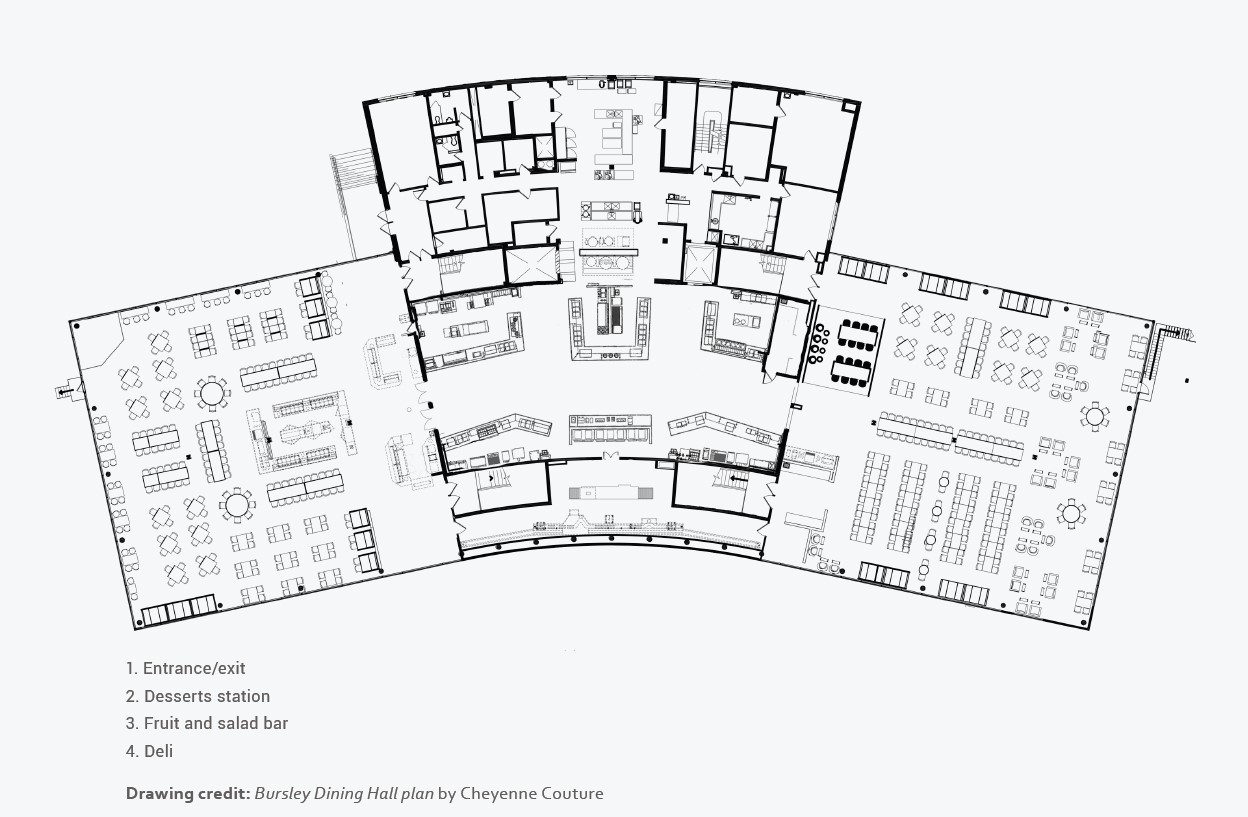︎ MDining Design
Diet & Activity Decisions
By Thea Thorrell ︎

 Photo credit: Mosher-Jordan Dining Hall by Anton Grassl/ESTO
Photo credit: Mosher-Jordan Dining Hall by Anton Grassl/ESTO
Hypothesis
The following project takes a semi-comprehensive approach when rethinking the design of the University of Michigan – Ann Arbor’s Dining Halls, which ultimately influences students’ diet, eating behaviors and physical activities. The information the university does not provide to its students, the lack of proper product design in addition to some paramount interior and architectural decisions are exacerbating obesity rates as well as the prevalence of eating disorders.
The following project takes a semi-comprehensive approach when rethinking the design of the University of Michigan – Ann Arbor’s Dining Halls, which ultimately influences students’ diet, eating behaviors and physical activities. The information the university does not provide to its students, the lack of proper product design in addition to some paramount interior and architectural decisions are exacerbating obesity rates as well as the prevalence of eating disorders.
- What/ So What?
Informing students about healthier options and the amount of food waste they contribute to as well as daily composting percentages, will help reduce waste.

1. Locating restaurants in different areas instead of one major core will promote more physical movement.
2. The incorporation of Dining Halls with two floors instead of one will also promote more physical movement.
3. According to research conducted by Gilston and Privitera (2015), color schemes that include more subtle and neutral colors will increase healthier dining behaviors.
4. With respect to a preceding study (Ittersum & Wansink, 2012), replacing wooden tables with white ones (or white tablecloth) will decrease negative dining practices.
Design to Outcomes
- The distribution of media will inform students regarding the amount of food waste they contribute to as well as daily composting percentages and will prevent them from selecting food they do not consume.
-
Restricting buffet-style dining by charging based on meal/plate weight will promote more careful meal selection and will also prevent students from
wasting food.
-
Placing fruit stations instead of dessert stations near the entrances/exits
will promote the selection of healthier snacks on students’ way out.
-
Placing bigger plates and bows by the fruit and salad bars and smaller plates by the Pizza and Grill restaurants will promote healthier eating habits.
︎
Works Cited
1. Onufrak, S. J., Watson, K. B., Kimmons, J., Pan, L., Khan, L. K., Lee-Kwan, S. H., & Park, S. (2018). Worksite Food and Physical Activity Environments and Wellness Supports Reported by Employed Adults in the United States. American journal of health promotion : AJHP, 32(1), 96–105. https://doi.org/10.1177/0890117116664709
2. Quintiliani, Lisa, Sattelmair, Jacob, and Sorensen, Glorian. (2007). The workplace as a setting for interventions to improve diet and promote physical activity. World Health Organization. https://www.who.int/dietphysicalactivity/Quintiliani-workplace-as-setting.pdf?ua=1
3. Johns Hopkins Bloomberg School of Public Health. Institute for Health and Productivity Studies. ; Centers for Disease Control and Prevention (U.S.) (2016) .Physical Activity in the Workplace: A Guide for Employers. The Institute for Health and Productivity Studies, Johns Hopkins Bloomberg School of Public Health. https://www.jhsph.edu/research/centers-and-institutes/institute-for-health-and-productivity-studies/_docs/archived-projects/WHRN_PA.pdf
4. Siegel, RP (2013). How Biking Improves Employee Productivity. Tripli Pundit the business of doing better. https://www.triplepundit.com/story/2013/how-biking-improves-employee-productivity/59136